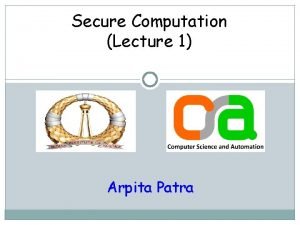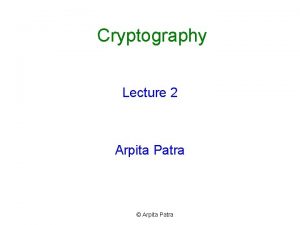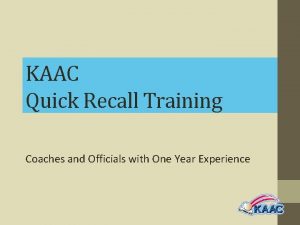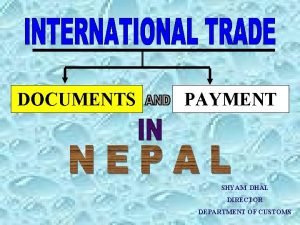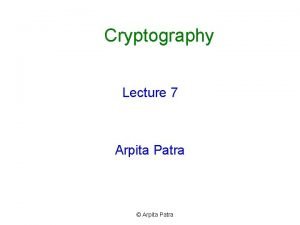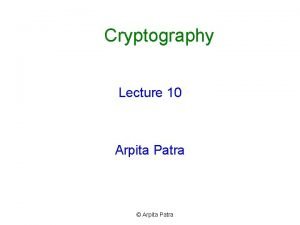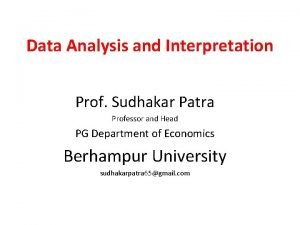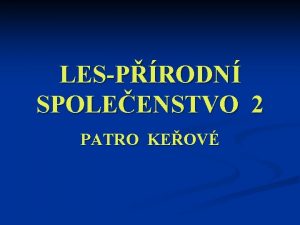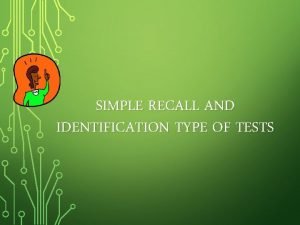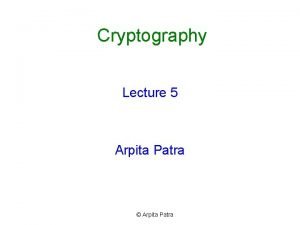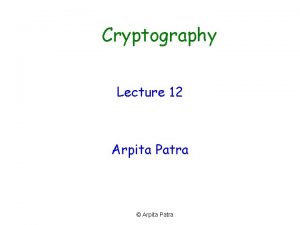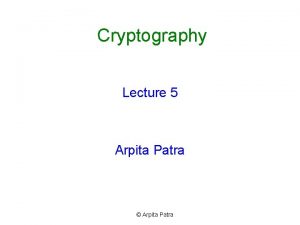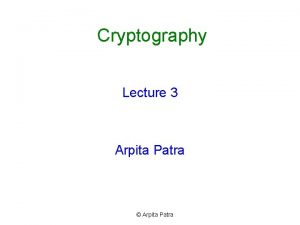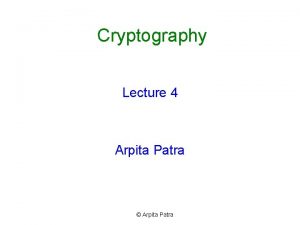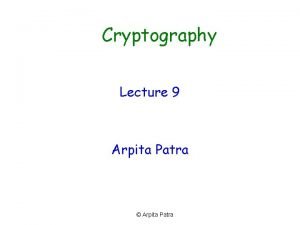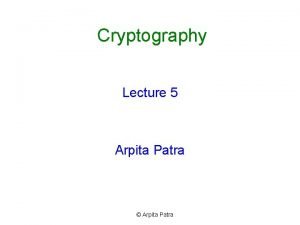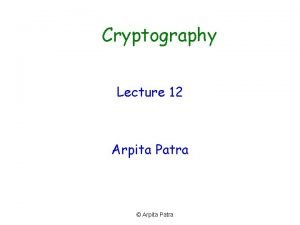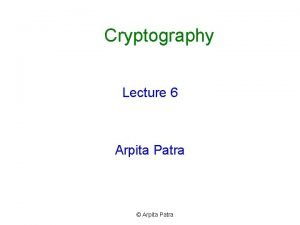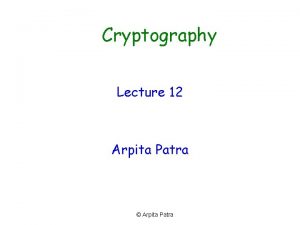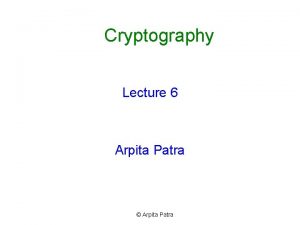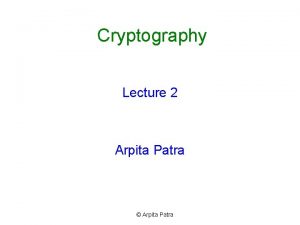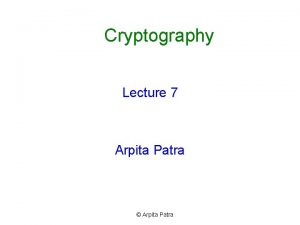Cryptography Lecture 5 Arpita Patra Quick Recall and


















- Slides: 18

Cryptography Lecture 5 Arpita Patra

Quick Recall and Today’s Roadmap >> CCA Security, more stronger than CPA security >> Break of CBC Mode CPA secure scheme under CCA- Padding Oracle Attack >> MAC >> Security Definitions: CMA, s. CMA. CMVA, s. CMVA >> PRF-based MAC >> Domain Extension for MAC: To handle arbitrary length message Not at all an easy task; Naïve construction (by Goldreich); Proof of Security CBC-MAC: Practical Domain Extension >> Authenticated Encryption: Privacy and Integrity Notion that subsumes CCA-security Construction (again a bit tricky) proof of Security

CMA Security for MAC cma = (Gen, Mac, Vrfy), n Experiment Mac-forge (n) A, Attacker A (m, t) I can break Run time: Poly(n) Q = {(m 1, …, ml } Forged tag generated by A k Training Phase Let me verify game output Ø 1 (A succeeds) if Vrfyk(m, t) = 1 and m Q Ø 0 (A fails) otherwise is CMA- secure if for every A, there is a negl(n) such that cma Pr [Mac-forge (n) = 1] negl(n) A, Gen(1 n)

Strong CMA Security for MAC cma Experiment Mac-sforge (n) A, = (Gen, Mac, Vrfy), n Attacker A (m, t) I can break Run time: Poly(n) Q = {(m 1, t 1), …, (ml , tl)} Forged tag generated by A k Training Phase Let me verify game output Ø 1 (A succeeds) if Vrfyk(m, t) = 1 and (m, t) Q Ø 0 (A fails) otherwise is strong CMA-secure if for every A, there is a negl(n) such that cma Pr [Mac-sforge (n) = 1] negl(n) A, Gen(1 n)

Fixed-length MAC from PRF q Let F: {0, 1}n x {0, 1}n be a PRF Then = (Gen, Mac, Vrfy) is a fixed-length MAC for n-bit strings where : k 1 n Gen k R {0, 1}n m {0, 1}n Mac k t: = Fk(m) m, t (Deterministic Mac) Vrfy 0, if t Fk(m) 1, if t = Fk(m) Theorem: If F is a PRF then is a CMA-secure MAC. Ø Show that if is not CMA-secure then F is not a PRF by designing a distinguisher for F Ø If instead a TRF f was used to compute tag then an attacker can guess f(m) for a “new” m with probability at most 2 -n Ø The same should hold even if a PRF is used (as key is unknown)

Domain Extension Given a scheme that handles fixed-length message. How to handle arbitrary-length messages SKE Break the message into blocks and encrypt each block using fixed-length scheme (minimum security notion CPAsecurity) Want efficiency? – Go for Mode of operations MAC The same does not work here– Additional tricks necessary Want efficiency? – CBC-MAC, Hash-and-MAC, HMAC

Domain Extension Warning!! Simple ideas do not work !! Attempt I Ø Divide the message into blocks and authenticate each separately via fixed-length MAC m k n n n m 1 m 2 m 3 Mac Mac t 1 = Mack(m 1) t 2 = Mack(m 2) t 3 = Mack(m 3) Mack(m) = t 1 || t 2 || t 3 Ø Block re-ordering attack : v Given (m, t), where m = m 1 || m 2 || m 3 and t = t 1 || t 2 || t 3 v Then (m’, t’) is a valid pair, where m’ = m 2 || m 1 || m 3 and t’ = t 2 || t 1 || t 3

Domain Extension for MAC Warning!! Simple ideas do not work !! Attempt II Ø Prevent the previous attack by authenticating block index along with each block n m 1 k m 1 Mac n 2 m 2 Mac t 1 = Mack(1 || m 1) t 2 = Mack(2 || m 2) n 3 m 3 Mack(m) = t 1 || t 2 || t 3 = Mack(3 || m 3) Ø Truncation attack : v A valid (msg, tag) pair can be generated by dropping (msg, tag) blocks from the end v (m 1 || m 2, t 1 || t 2) is a valid new (msg, tag) pair generated from (m 1 || m 2 || m 3, t 1 || t 2 || t 3)

Domain Extension for MAC Warning!! Simple ideas do not work !! Attempt III Ø Prevent the previous attack by additionally authenticating message length with each block l = 3 n m k l 1 m 1 Mac t 1 = Mack(l || 1 || m 1) l 2 m 2 Mac t 2 = Mack(l || 2 || m 2) l 3 m 3 Mack(m) = t 1 || t 2 || t 3 = Mack(l || 3 || m 3) Ø Mix-and-match attack : v Suppose attacker learns (m 1 || m 2 || m 3, t 1 || t 2 || t 3) and (m’ 1 || m’ 2 || m’ 3, t’ 1 || t’ 2 || t’ 3) where (m 1 || m 2 || m 3) = (m’ 1 || m’ 2 || m’ 3) v Then (m 1 || m’ 2 || m 3, t 1 || t’ 2 || t 3) is a valid, new (message, tag) pair

Domain Extension for MAC Warning!! Simple ideas do not work !! Ahhhh Finally! Attempt IV Ø Prevent the previous attack by additionally authenticating a random identifier with each block; a fresh random identifier for each message l m k r l 1 m 1 Mac t 1 = Mack(r || l || 1 || m 1) r l 2 m 2 r l Mac t 2 = Mack(r || l || 2 || m 2) 3 m 3 Mack(m) = t 1 || t 2 || t 3 = Mack(r || l || 3 || m 3) Ø Is this construction secure ? --- yes (it is in fact a randomized MAC) Ø Is Randomization necessary for domain extension? -- NO Ø But this is highly inefficient --- each invocation of Mac is now invoked only on n/4 bits of m v So if |m| = dn bits, then it requires 4 d invocations of Mac algorithm and tag size is 4 dn bits

Proof of Domain Extension for MAC l m r k l 1 m 1 Mac t 1 = Mack(r || l || 1 || m 1) r l 2 m 2 r l Mac t 2 = Mack(r || l || 2 || m 2) 3 m 3 Mack(m) = t 1 || t 2 || t 3 = Mack(r || l || 3 || m 3) Theorem: If ’ = (Mac’, Vrfy’) is CMA-secure for fixed-length message of length n, then = (Mac, Vrfy) is CMA-secure for arbitrary –length messages. Proof: On the board.

CBC-MAC for Arbitrary-length Messages q Let F: {0, 1}n x {0, 1}n be a PRF, whose key k is agreed between S and R q Let S has a message m with |m| = dn, where d is some polynomial in n q CBC-Mac: m m 2 m 1 m 3 |m| MAC & Proof Practical Domain Extension: CBC & k Differences with CBC Mode of operation for SKE. F F F 3 rd Chalk and Talk topic F Information-theoretic MAC (no assumption, simple t =in Mac k(m) construction, strong security, very useful high-level problems) q Length of m (i. e. |m|) need to be prepended, not appended --- otherwise insecure th Chalk and Talk topic 4 4 dn bits q The tag consists of only n bits Highly efficient q Only d invocations of PRF 4 d invocations of PRF

The Picture Till Now SKE MAC q Privacy q Integrity & Authentication q Not necessarily provide integrity and authentication; q Not necessarily provide privacy; >> easy to come of with a valid ciphertext >> easy to manipulate known ciphertext >> Easy to distinguish tags of two different messages Authenticated Encryption Jonathan Katz, Moti Yung: Unforgeable Encryption and Chosen Ciphertext Secure Modes of Operation. FSE 2000: 284 -299 Mihir Bellare, Chanathip Nampre: Authenticated Encryption: Relations among Notions and Analysis of the Generic Composition Paradigm. ASIACRYPT 2000: 531 -545

Authenticated Encryption AE Open channel Secure & Authenticated channel q But how do we define such security of such a primitive ? q Way out: try to capture secrecy and authenticity/integrity separately in the definition is an authenticated encryption scheme if no PPT attacker is able to nonq Let = (Gen, Enc, Dec) negligibly be a symmetric-key cipher. Intuitively win the CCA-experiment and we demand the following secrecy and integrity property to be satisfied with by respect to qualify Enc-Forge experiment to it as an AE scheme : Ø For secrecy, we demand CCA security: no PPT attacker should be able to nonnegligibly distinguish between encryption of two messages of its choice, even if it has access to encryption and decryption oracle service --- the best we can hope for at the privacy front >> Enc-Forge is similar in spirit of Mac-forge >> We need to introduce new game and definition since MAC and SKE has different sintax Ø For integrity/authentication, we demand something similar to CMA security for MAC. No PPT attacker who might have seen several encryptions generated by in the “past” is unable to come up with a valid ciphertext (forging a ciphertext) for to a (new) message for which he has never seen a ciphertext. v Modeled via a new experiment which exactly captures the above --- Enc-Forge

Unforgeable Encryption Experiment Enc-Forge (n) A, PPT Attacker A = (Gen, Enc, Dec) Encryption Oracle message I can forge Q = {m 1, …, mt} k Encryption Let me verify Ciphertext c game output Deck(c) = m and m Q 1 Deck(c) = m = or m Q 0 is unforgeable if for every PPT A: Pr Enc-Forge (n) =1 negl(n) A, Gen(1 n)

Authenticated Encryption (Formal Definition) q A symmetric-key cipher = (Gen, Enc, Dec) is an authenticated cipher if both the following holds: Ø is CCA-secure v For every PPT adversary A participating in the CCA-experiment, there is a negligible function negl 1(), such that: cca Pr Priv. K (n) = 1 A, ½ + negl 1(n) Ø is unforgeable v For every PPT adversary A participating in the unforgeable encryption experiment, there is a negligible function negl 2(), such that: Pr Enc-Forge (n) A, negl 2(n)


CBC-MAC vs CBC-mode of Encryption m q Random IV present in CBC-mode of encryption |m| Ø Very crucial for security q Will there be any harm if we use a random IV in CBC-MAC ? F F F t = Mack(m) q In CBC-mode of encryption, the intermediate values are also part of the output (ciphertext) m IV Ø Yes; it will become insecure !! m 1 m 2 k F q We should be very careful in implementing crypto primitives Ø Should clearly follow the specifications m 2 k Ø Yes; it will become insecure !! q Will there be any harm if we include the intermediate values in CBC-MAC as part of the tag ? m 1 c 0 c 1 = Fk(m 1 c 0) F c 2 = Fk(m 2 c 1)
 Arpita choudhury age
Arpita choudhury age Recallcrypto. com
Recallcrypto. com Quick recall questions
Quick recall questions Quick find algorithm
Quick find algorithm Collision forces quick check
Collision forces quick check 01:640:244 lecture notes - lecture 15: plat, idah, farad
01:640:244 lecture notes - lecture 15: plat, idah, farad Sudhakar patra
Sudhakar patra Mechové patro
Mechové patro What is pragyapan patra
What is pragyapan patra Cipher patra
Cipher patra Akshaya patra donation online
Akshaya patra donation online Goutam patra
Goutam patra Era of quality at the akshaya patra foundation
Era of quality at the akshaya patra foundation Cipher patra
Cipher patra Sudhakar patra
Sudhakar patra Rostlinná patra
Rostlinná patra Precision recall information retrieval
Precision recall information retrieval Difference between recall and recognition
Difference between recall and recognition What type of test is identification
What type of test is identification
